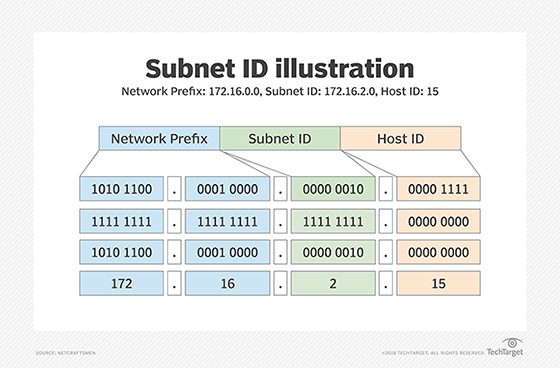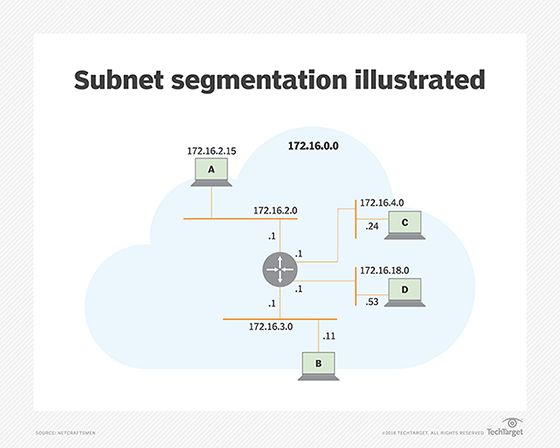what is the purpose of assigning ip addresses and subnet masks to the interfaces of the router
What is a subnet?
A subnet, or subnetwork, is a segmented piece of a larger network. More than specifically, subnets are a logical partition of an IP network into multiple, smaller network segments. The Cyberspace Protocol (IP) is the method for sending data from 1 computer to another over the internet. Each computer, or host, on the cyberspace has at to the lowest degree one IP address every bit a unique identifier.
Organizations will use a subnet to subdivide big networks into smaller, more efficient subnetworks. One goal of a subnet is to dissever a big network into a grouping of smaller, interconnected networks to help minimize traffic. This way, traffic doesn't take to flow through unnecessary routs, increasing network speeds.
Subnetting, the sectionalization of a network accost space, improves address allotment efficiency. It is described in the formal certificate, Request for Comments 950, and is tightly linked to IP addresses, subnet masks and Classless Inter-Domain Routing (CIDR) notation.
How do subnets work?
Each subnet allows its connected devices to communicate with each other, while routers are used to communicate between subnets. The size of a subnet depends on the connectivity requirements and the network technology employed. A point-to-point subnet allows two devices to connect, while a data eye subnet might exist designed to connect many more devices.
Each organization is responsible for determining the number and size of the subnets it creates, within the limits of the address space bachelor for its utilise. Additionally, the details of subnet sectionalization within an organization remain local to that organisation.
An IP accost is divided into 2 fields: a Network Prefix (also chosen the Network ID) and a Host ID. What separates the Network Prefix and the Host ID depends on whether the address is a Class A, B or C address. Figure 1 shows an IPv4 Class B address, 172.16.37.five. Its Network Prefix is 172.16.0.0, and the Host ID is 37.v.

The subnet machinery uses a portion of the Host ID field to identify private subnets. Figure 2, for case, shows the third group of the 172.16.0.0 network being used as a Subnet ID. A subnet mask is used to identify the part of the address that should be used equally the Subnet ID. The subnet mask is applied to the full network accost using a binary AND operation. AND operations operate, bold an output is "true" only when both inputs are "true." Otherwise, the output is "simulated." Just when two bits are both 1. This results in the Subnet ID.
Effigy 2 shows the AND of the IP accost, too as the mask producing the Subnet ID. Any remaining address $.25 identify the Host ID. The subnet in Figure two is identified every bit 172.16.2.0, and the Host ID is v. In practice, network staff will typically refer to a subnet past just the Subnet ID. It would be common to hear someone say, "Subnet two is having a trouble today," or, "There is a problem with the dot-ii subnet."

The Subnet ID is used by routers to determine the best route between subnetworks. Figure 3 shows the 172.16.0.0 network, with the third grouping every bit the Subnet ID. Four of the 256 possible subnets are shown connected to one router. Each subnet is identified either by its Subnet ID or the subnet address with the Host ID set to .0. The router interfaces are assigned the Host ID of .1 -- e.g., 172.16.2.ane.
When the router receives a packet addressed to a host on a unlike subnet than the sender -- host A to host C, for example -- information technology knows the subnet mask and uses it to determine the Subnet ID of host C. It examines its routing table to observe the interface connected to host C's subnet and frontwards the package on that interface.
Subnet division
A subnet itself as well may exist segmented into smaller subnets, giving organizations the flexibility to create smaller subnets for things like bespeak-to-point links or for subnetworks that support a few devices.
The example below uses an eight-bit Subnet ID. The number of bits in the subnet mask depends on the organization's requirements for subnet size and the number of subnets. Other subnet mask lengths are common. While this adds some complication to network addressing, it significantly improves the efficiency of network address utilization.

A subnet tin can be delegated to a suborganization, which itself may apply the subnetting process to create additional subnets, as long every bit sufficient address space is available. Subnetting performed by a delegated organization is hidden from other organizations. As a effect, the Subnet ID field length and where subnets are assigned tin can be hidden from the parent (delegating) organization, a fundamental characteristic that allows networks to be scaled up to big sizes.
In modern routing architectures, routing protocols distribute the subnet mask with routes and provide mechanisms to summarize groups of subnets every bit a single routing table entry. Older routing architectures relied on the default Class A, B and C IP address classification to determine the mask to use.
CIDR notation is used to identify Network Prefix and Mask, where the subnet mask is a number that indicates the number of ones in the Mask (eastward.thou., 172.16.ii.0/24). This is besides known as Variable-Length Subnet Masking (VLSM) and CIDR. Subnets and subnetting are used in both IPv4 and IPv6 networks, based on the same principles.
What are subnets used for?
- Reallocating IP addresses. Each class has a express number of host allocations; for example, networks with more than than 254 devices need a Class B allocation. If a network administrator is working with a Form B or C network and needs to allocate 150 hosts for iii concrete networks located in three different cities, they would need to either request more than accost blocks for each network -- or split up a network into subnets that enable administrators to use one block of addresses on multiple physical networks.
- Relieving network congestion. If much of an organization's traffic is meant to exist shared regularly between the same cluster of computers, placing them on the same subnet tin reduce network traffic. Without a subnet, all computers and servers on the network would run across data packets from every other figurer.
- Improving network security. Subnetting allows network administrators to reduce network-wide threats by quarantining compromised sections of the network and by making information technology more difficult for trespassers to move around an organization's network.
This was last updated in September 2021
Proceed Reading About subnet (subnetwork)
- How to calculate a subnet mask from hosts and subnets
- 7 factors to consider in network back-up design
- VLAN vs. subnet: What's the difference?
- Subnet Routing Examples
Dig Deeper on Campus area network
-

How to calculate a subnet mask from hosts and subnets
-

IP subnetting: How to calculate subnet masks
-

logical network
-

What is a logical network? How do you ameliorate 1?
Source: https://www.techtarget.com/searchnetworking/definition/subnet

0 Response to "what is the purpose of assigning ip addresses and subnet masks to the interfaces of the router"
Post a Comment